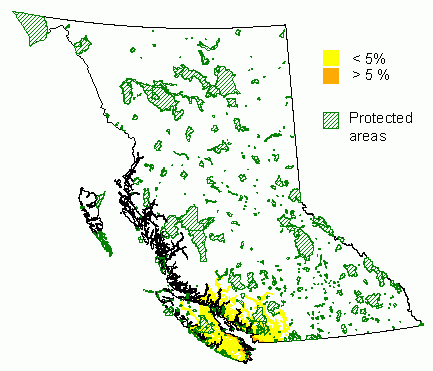 Bigleaf maple
Bigleaf maple
Acer macrophyllum Pursh
Introduction
Bigleaf maple is a deciduous, broadleaved tree with a broad, rounded crown, up to 30 m tall. Several stems originating from the same stump may form a cluster. The species is moderately shade tolerant, occurs on coarse, gravelly moist soils, and occasionally occupies newly disturbed sites. No major pests or diseases are associated with this species. The seeds are an important food source for small mammals (Uchytil 1989; Burns and Honkala 1990; Klinka et al. 2000). The first peoples considered it an excellent fuel and used the wood for carving utensils (Turner 1979).
Bigleaf maple occurs from Southwestern British Columbia (including Vancouver Island) to California along the coast, i.e., in the central and south of the Pacific region, as well as an area south in the Cordilleran region. In BC, Bigleaf maple occurs mainly in the CWH zone, where it is common, in the CDF zone, where it is fairly abundant, and the IDF zone, where it is uncommon.
Distribution and Protected Areas – from Hamann et.al. 2005



Conservation Status Summary – from Chourmouzis et.al. 2009
No in situ conservation concerns were identified for this species.
Reproduction
During most years, bigleaf maple produces abundant seeds (Fried et al. 1988; Banerjee et al. 2001), which are dispersed by wind. Bigleaf maple sprouts profusely after being cut. Despite a high rate of seed predation, seedling emergence (Tappeiner and Zasada 1993) and regeneration capacity are excellent. Bigleaf maple was formerly considered a weed. Recently, its contribution to stand- and species diversity and its commercial potential have been recognized (Peterson 1999).
Genetic structure
No information available.
Resource management and seed transfer
No information available.
REFERENCES
Hamann, A., Smets, P., Aitken, S. N. and Yanchuk, A. D. 2005. An ecogeographic framework for in situ conservation of forest trees in British Columbia. Can. J. For. Res. 35:2553-2561. View online resources for this report.
C. Chourmouzis, A.D. Yanchuk, A. Hamann, P. Smets, and S.N. Aitken. 2009. Forest Tree Genetic Conservation Status Report 1: In situ conservation status of all indigenous BC species. Centre for Forest Conservation Genetics, Forest Genetics Council of BC, and BC Ministry of Forests and Range, Forest Science Program, Victoria, BC Technical Report 053. www.for.gov.bc.ca/hfd/pubs/Docs/Tr/Tr053.htm
Banerjee, S. M., Creasy, K. and Gertzen, D. D. 2001. Native woody plant seed collection guide for British Columbia. Crown Publications, Victoria. 147 p.
Burns, R. M. and Honkala, B. H. 1990. Silvics of North America, vol. 2: Hardwoods. Agriculture handbook 654. U.S. Dept. of Agriculture Forest Service, Washington, D.C. 877 p.
Fried, J. S., Tappeiner, J. C. I. and Hibbs, D. E. 1988. Bigleaf maple seedling establishment and early growth in Douglas-fir forests. Canadian Journal of Forest Research 18:1226-1233.
Klinka, K., Worrall, J., Skoda, L. and Varga, P. 2000. The distribution and synopsis of ecological and silvical characteristics of tree species of British Columbia’s forests. Canadian Cartographics Ltd., Vancouver. 180 p.
Peterson, E. B. 1999. Bigleaf maple managers’ handbook for British Columbia. British Columbia Ministry of Forests Research Program, Victoria, B.C. 105 p.
Tappeiner, J. C. and Zasada, J. C. 1993. Establishment of salmonberry, salal, vine maple, and bigleaf maple seedlings in the coastal forests of Oregon. Canadian Journal of Forest Research 23:1775-1780.
Turner, N. J. 1979. Plants in British Columbia Indian technology. B.C. Provincial Museum Handbook no. 38. BC Provincial Museum, Victoria, B.C. 304 p.
Uchytil, R. J. 1989. Acer macrophyllum. U.S. Department of Agriculture, Forest Service, Rocky Mountain Research Station, Fire Sciences Laboratory (2002, January). Fire Effects Information System. [Online]. Available: http://www.fs.fed.us/database/feis/ [January 2002].
